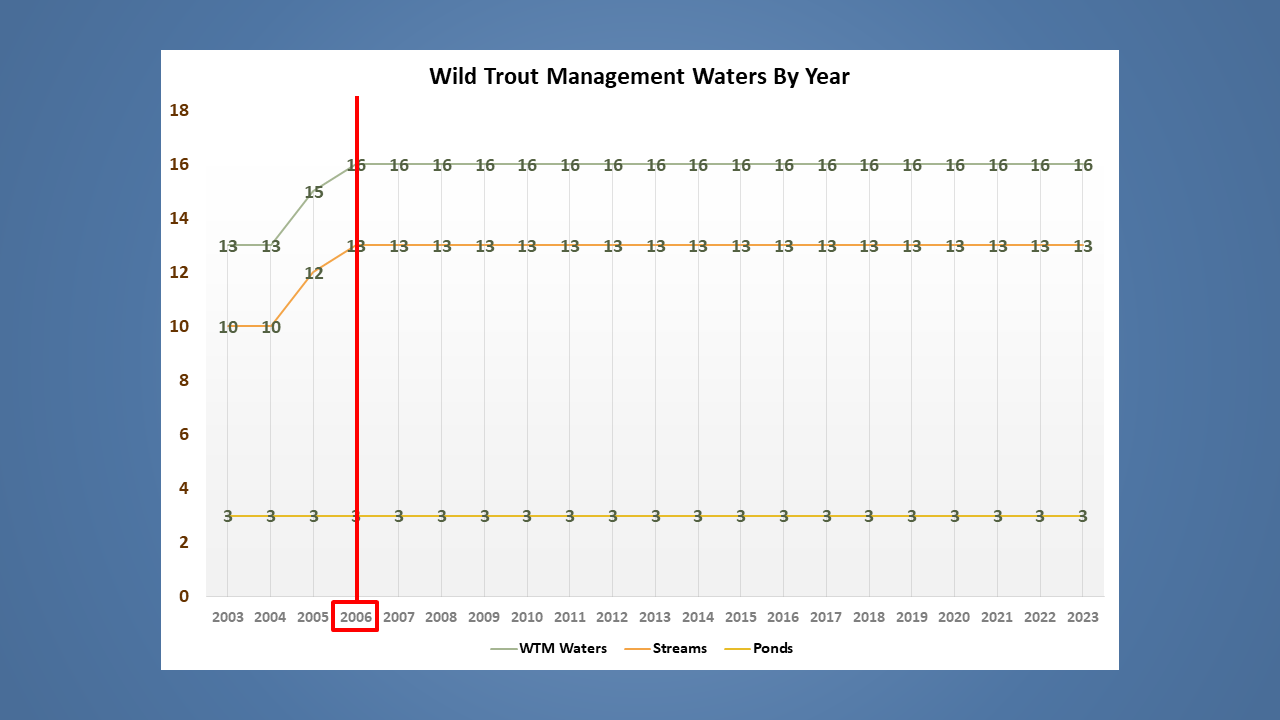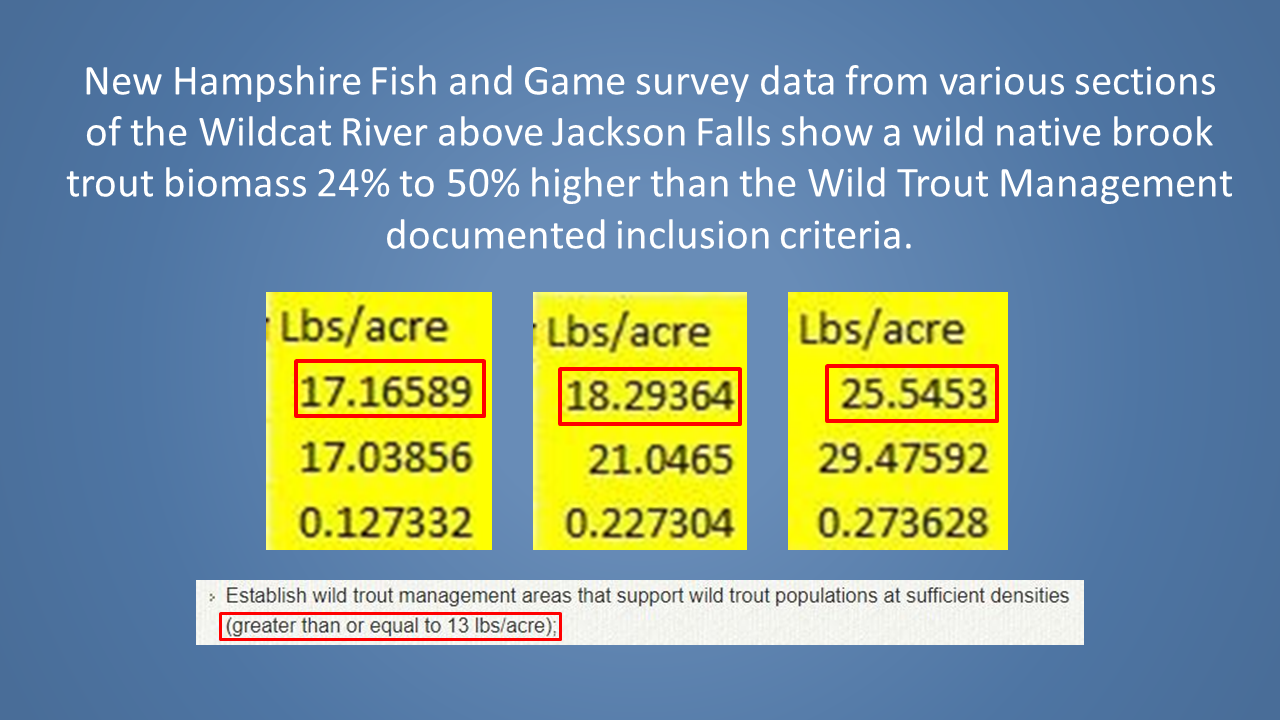New Hampshire House Bill 1417-FN: The Facts and Status...
www.wildlife.nh.gov/fishing-new-hampshire/trout-fishing-new-hampshire/wild-trout-management-nh
“With only 16 waters statewide and none added in 17 years, and numerous failed attempts to work informally with New Hampshire Fish and Game to address it, NFC feels that legislative action is likely the only option left to try to save and expand the critically important Wild Trout Management program...”
background…
New Hampshire House Bill 1417-FN looks to codify, or put into law, the states faltering Wild Trout Management program. WTM is the only formal program in New Hampshire that protects wild native brook trout from stocking, high-impact tackle, and angler exploitation.
NFC wants to save and expand the WTM program. We have spent years lobbying for a resurrection of the program but to no avail. The failure to add any new waters to WTM in 17 years spans 2 New Hampshire Fish and Game executive directors and at least 2 fisheries directors.
While NHFG has made notable strides in regard to lessening stocking over wild trout, and there are apparently more positive changes coming, stocking is just one of many things that negatively impact wild trout populations. Wild trout are also impacted by angler exploitation as evident by the often notable lack of fish, and/or large fish, in the frontcountry and public access sites.
By default, waters that meet the documented WTM inclusion criteria, 13lbs per acre, represent the strongest populations of wild trout in the state. By imposing protective angling restrictions on these waters via WTM, we allow wild trout populations to meet their potential which also helps protect them from things we cannot influence such as floods, droughts, habitat degradation, predation, diseases, viruses, and parasites.
“NFC is not trying to change the WTM program, just codify it so there is more opportunity for public input and outside oversight...”
nh Wild Trout Management…
In 2003, NHFG enacted what is known as the Wild Trout Management program. The intention of the program was to protect wild trout waters from stocking, high impact tackle, and harvest. It is the only formal program in the state for protecting wild trout.
Thirteen waters were added to WTM in 2003, 2 were added in 2005, and 1 water was added in 2006 for a statewide total of 16 waters - 13 small streams and 3 small ponds. While not specific to brook trout, the program has been applied to almost exclusively brook trout waters.
NH’s WTM program is in trouble and has been for some time. No waters have been added in 17 years, designated waters have been stocked, one water disappeared from the list temporarily, and several important informational webpages have been orphaned or removed from the NHFG website in the past several years.
There are also gaping holes in the WTM map, including the White Mountains region. This is true from both a gross number standpoint as well as a percentage of applicable waters in regard to the White Mountains region. In fact, no area in the state is more poorly represented when you consider the potential.
Waters such as the Wildcat River have been omitted from WTM despite the fact that documented wild trout biomass far exceeds the documented inclusion criteria. Other waters have state-sponsored data to warrant their inclusion in WTM, yet they have not been added to the program either.
stocking over Wild native Trout…
A stocked nonnative rainbow trout from the Ellis River near Jackson, NH.
Stocking over wild native brook trout is not uncommon in New Hampshire. This is especially true with regard to the White Mountains region where once robust wild native trout fisheries such as the Ammonoosuc, Ellis, Gale, Israel, Saco, Swift, and Zealand Rivers are now propped up almost solely through stocking.
A stocked brook trout from the wild fish rich lower Wildcat River in Jackson, NH.
In the case of the Wildcat River, while NH NFC was able to negotiate a stocking suspension in the river upstream of Jackson Falls, a natural barrier to fish passage, we were unable to get it stopped downstream of the falls even though it has a robust wild brook trout population that exceeds the WTM inclusion criteria.
Stocking data obtained from NHFG.
During a recent Zoom with NHFG, a spokesperson for the department noted that Echo Lake in the White Mountains had a notable wild brook trout population. Yet the lake is stocked annually, with over 3,100 fish stocked in 2021, not including over 30,000 “surplus” fingerlings.
When asked why they were knowingly stocking over a wild native brook trout, NHFG said it was to address heavy angler use. Bait is allowed on Echo Lake, the daily bag limit is 5 fish or 5 pounds, and there is no length limit. Stocking should be the last resort to address angler exploitation, not the first action taken.
Stocking data obtained from NHFG.
who’s doing what…
While there has been some criticism from within the NH trout conservation community that NFC went “whining to the legislature,” and filed “frivolous bills,” neither is true. Statements like this only serve to further divide the ranks while playing right into the hands of those who have failed repeatedly to address the problem.
Although NFC has no problem doing so, nor should anyone else as legislation is a legitimate and valuable tool for influencing change, we did not initiate HB1417-FN. NFC along with other organizations were approached by NH State Rep. Ellen Read in regard to supporting a bill to protect wild native brook trout. Failure to listen would be to ignore and deny the harsh realities in regard to the state of wild native trout management in NH.
The bill, HB1417-FN, follows a similar bill, HB241, submitted by Rep. Ellen Read on behalf of a non-NFC constituent in 2021. The intent of HB241 was to prohibit stocking over wild brook trout as well as change the biologically unsound multi-species definition of “brook trout” in rule with something that reflected brook trout only, and wild brook trout specifically.
NFC’s role in regard to HB241 was to help define what should be done about the definition of brook trout. While the bill failed, the legislature agreed to remove the flawed definition of brook trout from statute, paving the way for NHFG to address it in rule via removal or rewording. Effective 2024, the multi-species definition for brook trout has been replaced with a similar definition for “Trout” as suggested by NFC.
Believing that legislation was justified considering the status of WTM, and likely needed if we are to save and expand the program, NFC worked with the sponsoring legislator to try to influence the direction of HB1417-FN as well. With 17 years of inactivity and backsliding, the current strategy was clearly not working and a change of strategy was not only warranted, but necessary.
NFC’s goal with regard to HB1417-FN was simply to codify WTM as it now stands so as to increase the opportunity for public input and gain some additional oversight.
sportsman and Legislation…
The legislative process is and has been used by sportsmen for decades to protect our rights, access to public lands and waters, as well as the resources we depend on. Maine’s landmark State Heritage Fish program was the result of legislation driven by Sportsman’s Alliance of Maine and others to protect the states last wild native brook trout lakes and ponds from stocking and the use of live fish as bait.
It was sportsman initiated legislation that led to Maine’s sweeping prohibition on the dangerous use of live fish as bait in the critically important North Zone, home to a majority of the states wild native salmonids. By bringing the issue to the attention of the legislature, Maine Department of Inland Fisheries and Wildlife was told to address the problem.
where nfc now stands…
Unfortunately, having been unable to address concerns with regard to scope creep, and superfluous and ambiguous language in the bill that could cause unnecessary opposition to the bill and problems up the road, NFC has formally withdrawn our support for HB1417-FN.
While NFC still believes that legislation will likely be required to save and expand the WTM program, we do not believe that the bill as it currently written will accomplish those goals.
Rather than supporting bills submitted by others where our influence is limited, NFC has drafted our own language and will be looking for a legislator to submit a bill on our behalf up the road.
NFC will also be reaching out to NHFG to try to gain a better understanding of why they are unwilling to expand WTM, and what if anything could be done to change their mind without the need for legislation. While this approach has failed to yield positive results in the past, and NFC has reached out to NHFG repeatedly, maybe having to deal with 2 bills and the chance of another will open the door to discussion.









